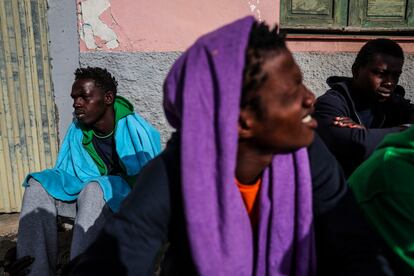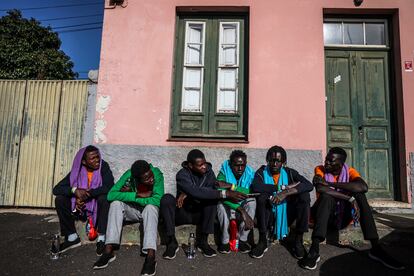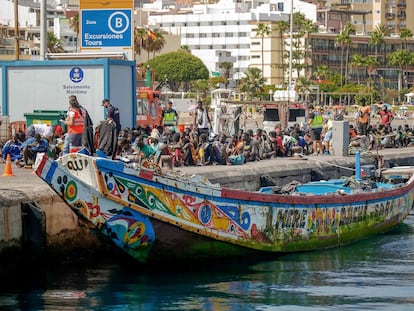Surge in migrant boats to Spain’s Canary Islands stretches resources thin
Since October 1, more than 5,000 people have landed on the islands, a figure that has forced the Spanish government to organize transfers to the mainland


The number of migrant boats arriving in the Canary Islands in recent months — and especially in the last two weeks — is pushing Spain’s reception resources to the limit. Since October 1, more than 5,000 people have landed on the islands, a figure that has forced the Spanish government to organize transfers to the mainland to avoid the collapse of services in the archipelago.
Despite efforts to solve similar situations in the past when thousands of migrants slept on the dock or in improvised ships, the volume is now so intense, with more than 1,000 people disembarking in just a few hours on days such as October 6, that there is little room for maneuver. The number of people emigrating from Senegal has exceeded all projections.
At the beginning of this week, occupancy of the migrants centers in mainland Spain was around 80% of the approximately 4,500 beds available, according to inside sources. Meanwhile, in the Canary Islands, where approximately 3,700 migrants are housed, that figure stands at 90%. The country’s Ministry of Inclusion, Social Security and Migration maintains, however, that the situation is under control, that the occupation in the mainland’s centers stands at 60% and that 1,000 new beds can be made immediately available.
The system became much more flexible after the outbreak of the Ukraine war in March 2022, when Spain took in tens of thousands of refugees. During that scenario, an emergency was declared, making it possible to access economic resources to guarantee adequate reception. Right now, the Ministry is reluctant to apply this measure, though the department headed by Minister José Luis Escrivá held meetings on Thursday, October 12, to look for solutions before the next wave of arrivals. “It is difficult to quickly increase the capacity of the system,” said one source involved with migrant care.
The humanitarian reception network provides basic assistance to new arrivals, ensuring those arriving in precarious situations, with no money or family, don’t end up on the street. It also offers a period of respite and a degree of financial support to help them with their ongoing journey. As a general rule, a stay at one of these centers cannot exceed three months, a period that has now been reduced to one month to accommodate the intensity of arrivals. So far this year, more than 20,000 people have arrived in the Canary Islands, an increase of more than 50% on 2022. The upward trend is mirrored on the mainland and the Balearic Islands, although to a lesser extent.
The situation in the Canary Islands now is very different from that of 2020, when the migratory route from the African coasts was strongly reactivated in the midst of the pandemic. Although the number of arrivals will certainly be exceeded, one of the key changes is that the central government is quickly transferring migrants to the mainland, sometimes in a matter of days.

Express referrals to the mainland have indeed decongested the islands, but the authorities still find that more people arrive than can be transferred. Moreover, reception resources on the mainland are also finite. The main challenge is the unpredictability of the coming months, which could record a historic high of arrivals due to good sea conditions. José Sánchez Espinosa, director of the Red Cross’ Social Inclusion department which is key to managing the reception of migrants, explains that the actual numbers are not of primary concern despite the fact last year’s figures have already been surpassed. “The main concern is the concentration of arrivals in short periods of time,” he says. “From June until now we have attended three times as many people as last year and that is worrying considering that the season of more arrivals is yet to come. The scenario is very unpredictable, but we are already preparing for an emergency.”
These transfers to the mainland were a source of tension three years ago between the Ministry of Migration and the Ministry of Interior, but now, despite the reluctance of Interior Minister Fernando Grande-Marlaska, it is seen as one of the few viable alternatives if the population balance on the islands is to be maintained. If more than 20,000 people have disembarked in the Canary Islands since January and almost 4,000 adults and more than 3,000 minors remain, it is estimated that about 13,000 migrants have been leaving the Canary Islands on their way to the mainland.
Referrals
In declarations to the Spanish state news agency Efe, the Spanish government delegate to the Canary Islands, Anselmo Pestana, has defended the referrals to the mainland in an approach that would have been unthinkable three years ago. Pestana has stated that the measure “is working reasonably well,” despite the fact that the islands are witnessing a spike in arrivals not seen since the 2006 migrant boats crisis. “Today there are 3,000 [migrants in the Canary Islands],” he said. “Probably, in the next few days that figure will be lower again, and we could be at around 1,000. The data is almost the proof of how the system is working, that they are referred to the mainland, that there is no conflict with local Canary society — far from it, and that the whole circuit from the time a migrant boat is detected […] until the migrant is in a center on the mainland is working reasonably well.”
In any case, the Canary Islands’ reception network has greater capacity than ever before. After the 2020 crisis, macro-camps and centers were set up and the number of beds grew exponentially, from barely 300 to the current 3,500, which can be more than doubled in an emergency. The point is that the Migrations Ministry is not in favor of forcing the system’s capacity on the islands and has been keeping it at around half: but a week like the ones we are currently experiencing can, in a few days, cause the centers to collapse. The challenge now lies in the management of migrants beyond the dock and the archipelago.

Sign up for our weekly newsletter to get more English-language news coverage from EL PAÍS USA Edition
Tu suscripción se está usando en otro dispositivo
¿Quieres añadir otro usuario a tu suscripción?
Si continúas leyendo en este dispositivo, no se podrá leer en el otro.
FlechaTu suscripción se está usando en otro dispositivo y solo puedes acceder a EL PAÍS desde un dispositivo a la vez.
Si quieres compartir tu cuenta, cambia tu suscripción a la modalidad Premium, así podrás añadir otro usuario. Cada uno accederá con su propia cuenta de email, lo que os permitirá personalizar vuestra experiencia en EL PAÍS.
¿Tienes una suscripción de empresa? Accede aquí para contratar más cuentas.
En el caso de no saber quién está usando tu cuenta, te recomendamos cambiar tu contraseña aquí.
Si decides continuar compartiendo tu cuenta, este mensaje se mostrará en tu dispositivo y en el de la otra persona que está usando tu cuenta de forma indefinida, afectando a tu experiencia de lectura. Puedes consultar aquí los términos y condiciones de la suscripción digital.
More information
Archived In
Últimas noticias
Most viewed
- Reinhard Genzel, Nobel laureate in physics: ‘One-minute videos will never give you the truth’
- Oona Chaplin: ‘I told James Cameron that I was living in a treehouse and starting a permaculture project with a friend’
- Pablo Escobar’s hippos: A serious environmental problem, 40 years on
- Why we lost the habit of sleeping in two segments and how that changed our sense of time
- Charles Dubouloz, mountaineering star, retires at 36 with a farewell tour inspired by Walter Bonatti










































